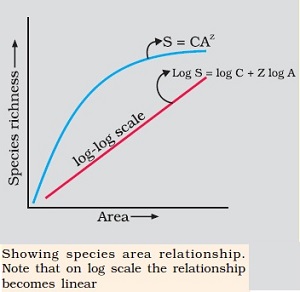Biodiversity and Conservation - Online Test
Q1. Speciation maintains biodiversity
Answer : Option C
Explaination / Solution:
Speciation, the formation of new and distinct species in the course of evolution. Speciation involves the splitting of a single evolutionary lineage into two or more genetically independent lineages.
Speciation maintains biodiversity both at species level and community level. New species develop from older species due to variation having more adaptive in changed habitat.
Add image here
Q2. Biodiversity is most frequently quantified as
Answer : Option D
Explaination / Solution:
Biodiversity is the presence of diverse kinds of living organisms in a particular habitat. It is most frequently quantified as number of species in particular geographical region.
Q3. Biological diversity level that doesn’t exist is:
Answer : Option C
Explaination / Solution:
Biological diversity level is classified as alpha, beta and gamma. Delta is not a biological diversity level.
The terms alpha, beta, and gamma diversity were all introduced by R. H. Whittaker to describe the spatial component of biodiversity. Imagine that you have a landscape containing of a number of separate sites and habitats. Alpha diversity is just the diversity of each site (local species pool). Beta diversity represents the differences in species composition among sites. Gamma diversity is the diversity of the entire landscape (regional species pool).
Q4. When we compare the relationship between species richness and area for wide variety of taxa, the graph appears to be a :
Answer : Option A
Explaination / Solution:
Explanation:
- Alexander Von Humboldt has observed that within a region, species richness gets increased when explored area is increased, but only up to a limit.
- The relationship between species richness and area for a number of taxa like angiospermic plants, fresh water fishes and birds is found to be a rectangular hyperbola.

The equation is described by –
log S = log C + Z log A
S – Species Richness
Z – Slope of the line (regression coefficient)
A – Area
C – y-intercept
Q5. Which article of the Constitution of India specifies that, "it shall be the duty of every citizen of India to protect and improve the natural environment including forests, lakes, rivers, and wildlife and to have compassion for living creatures."
Answer : Option B
Explaination / Solution:
All the fundamental duties are contained in Art. 51A.
to protect and improve the natural environment including forests, lakes, rivers, and wildlife and to have compassion for living creatures is a fundamental duty listed in constitution of India.
Q6. If all the members of a host species die then all its unique parasites also die off, representing:
Answer : Option C
Explaination / Solution:
Coextinction and cothreatened refer to the phenomena of the loss or decline of a host species resulting in the loss or endangerment of other species that depend on it, potentially leading to cascading effects across trophic levels.
Q7. If a sample area comprises of more number of taxonomically unrelated species, this will indicate
Answer : Option C
Explaination / Solution:
Richness is a measure of the number of different kinds of organisms present in a particular area.
A diverse sample area having more number of taxonomically unrelated species will indicate a more diverse sample area.
A sample area is used to know the diversity of a geographical area.
Q8. When we will move away from the equator towards poles, we will find
Answer : Option C
Explaination / Solution:
When we will move away from the equator towards poles there is a gradual decrease in the species diversity. This is because climatic condition becomes gradually adverse as we move from equator to poles.
Q9. In a wetland the primary factor controlling the environment and the associated plant and animal life will be
Answer : Option A
Explaination / Solution:
The area that is saturated with water is called wetland. In wetland the primary factor controlling the environment and the associated plant and animal life will be water.
Q10. If we say, India has about 50,000 type of rice and 1000 types of varieties of mango what level of diversity it indicates:
Answer : Option B
Explaination / Solution:
India has about 50,000 type of rice and 1000 types of varieties of mango. This high level of diversity indicates very high genetic diversity and one of the largest in the world.
